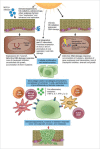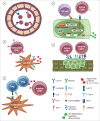Immune evasion mechanisms and immune checkpoint inhibition in advanced merkel cell carcinoma
- PMID: 29123950
- PMCID: PMC5665072
- DOI: 10.1080/2162402X.2017.1338237
Immune evasion mechanisms and immune checkpoint inhibition in advanced merkel cell carcinoma
Abstract
Merkel cell carcinoma (MCC) is a rare skin cancer caused by Merkel cell polyomavirus (MCPyV) infection and/or ultraviolet radiation-induced somatic mutations. The presence of tumor-infiltrating lymphocytes is evidence that an active immune response to MCPyV and tumor-associated neoantigens occurs in some patients. However, inhibitory immune molecules, including programmed death-1 (PD-1) and programmed death-ligand 1 (PD-L1), within the MCC tumor microenvironment aid in tumor evasion of T-cell-mediated clearance. Unlike chemotherapy, treatment with anti-PD-L1 (avelumab) or anti-PD-1 (pembrolizumab) antibodies leads to durable responses in MCC, in both virus-positive and virus-negative tumors. As many tumors are established through the evasion of infiltrating immune-cell clearance, the lessons learned in MCC may be broadly relevant to many cancers.
Keywords: Avelumab; Merkel cell carcinoma; PD-1; PD-L1; checkpoint inhibition; immune evasion; pembrolizumab.
Figures


Similar articles
-
Merkel Cell Carcinoma in the Age of Immunotherapy: Facts and Hopes.Clin Cancer Res. 2018 May 1;24(9):2035-2043. doi: 10.1158/1078-0432.CCR-17-0439. Epub 2017 Dec 7. Clin Cancer Res. 2018. PMID: 29217527 Free PMC article. Review.
-
Insights into anti-tumor immunity via the polyomavirus shared across human Merkel cell carcinomas.Front Immunol. 2023 May 23;14:1172913. doi: 10.3389/fimmu.2023.1172913. eCollection 2023. Front Immunol. 2023. PMID: 37287968 Free PMC article. Review.
-
Case Report: Exceptional Response to Avelumab After Failure of Electrochemotherapy in a Patient With Rapidly Progressive, PD-L1-Negative Merkel Cell Carcinoma.Front Oncol. 2021 Jun 17;11:628324. doi: 10.3389/fonc.2021.628324. eCollection 2021. Front Oncol. 2021. PMID: 34221958 Free PMC article.
-
Intratumoral STING agonist reverses immune evasion in PD-(L)1-refractory Merkel cell carcinoma: mechanistic insights from detailed biomarker analyses.J Immunother Cancer. 2024 Oct 14;12(10):e009803. doi: 10.1136/jitc-2024-009803. J Immunother Cancer. 2024. PMID: 39401968 Free PMC article.
-
[Immune checkpoint inhibition in Merkel cell carcinoma].Hautarzt. 2019 Sep;70(9):684-690. doi: 10.1007/s00105-019-4465-x. Hautarzt. 2019. PMID: 31468071 Review. German.
Cited by
-
"Present and future of immunotherapy in Neuroendocrine Tumors".Rev Endocr Metab Disord. 2021 Sep;22(3):615-636. doi: 10.1007/s11154-021-09647-z. Epub 2021 Apr 14. Rev Endocr Metab Disord. 2021. PMID: 33851319 Free PMC article. Review.
-
Efficacy and Safety of First-line Avelumab Treatment in Patients With Stage IV Metastatic Merkel Cell Carcinoma: A Preplanned Interim Analysis of a Clinical Trial.JAMA Oncol. 2018 Sep 1;4(9):e180077. doi: 10.1001/jamaoncol.2018.0077. Epub 2018 Sep 13. JAMA Oncol. 2018. PMID: 29566106 Free PMC article. Clinical Trial.
-
A disproportionality analysis of real-world events from the FDA Adverse Event Reporting System (FAERS) for Atezolizumab.BMC Pharmacol Toxicol. 2025 Mar 4;26(1):51. doi: 10.1186/s40360-025-00879-2. BMC Pharmacol Toxicol. 2025. PMID: 40038564 Free PMC article.
-
Merkel Cell Carcinoma.Biomedicines. 2021 Jun 23;9(7):718. doi: 10.3390/biomedicines9070718. Biomedicines. 2021. PMID: 34201709 Free PMC article. Review.
-
Merkel cell carcinoma in Latin America: a contribution from an expanded access program for avelumab to address issues from experts' recommendations.Cancer Immunol Immunother. 2021 Apr;70(4):1031-1036. doi: 10.1007/s00262-020-02756-9. Epub 2020 Oct 26. Cancer Immunol Immunother. 2021. PMID: 33104838 Free PMC article.
References
-
- Becker JC. Merkel cell carcinoma. Ann Oncol 2010; 21(suppl 7):vii81-5; PMID:20943647; https://doi.org/10.1093/annonc/mdq366 - DOI - PubMed
-
- Feng H, Shuda M, Chang Y, Moore PS. Clonal integration of a polyomavirus in human Merkel cell carcinoma. Science 2008; 319(5866):1096-100; PMID:18202256; https://doi.org/10.1126/science.1152586 - DOI - PMC - PubMed
-
- Harms PW, Vats P, Verhaegen ME, Robinson DR, Wu YM, Dhanasekaran SM, Palanisamy N, Siddiqui J, Cao X, Su F, et al.. The distinctive mutational spectra of polyomavirus-negative Merkel cell carcinoma. Cancer Res 2015; 75(18):3720-7; PMID:26238782; https://doi.org/10.1158/0008-5472.CAN-15-0702 - DOI - PMC - PubMed
-
- Wong SQ, Waldeck K, Vergara IA, Schroder J, Madore J, Wilmott JS, Colebatch AJ, De Paoli-Iseppi R, Li J, Lupat R, et al.. UV-associated mutations underlie the etiology of MCV-negative Merkel cell carcinomas. Cancer Res 2015; 75(24):5228-34; PMID:26627015; https://doi.org/10.1158/0008-5472.CAN-15-1877 - DOI - PubMed
Publication types
LinkOut - more resources
Full Text Sources
Other Literature Sources
Research Materials
